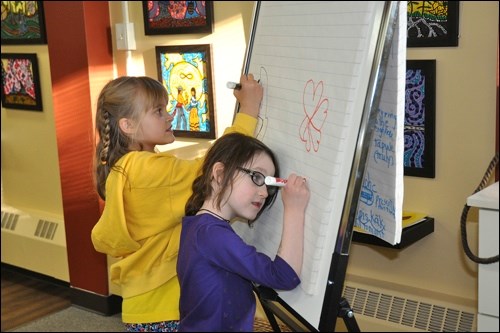Interdisciplinary M├ętis artist Leah┬áMarie Dorion is excited about a selection of her art becoming part of the permanent collection of the Allen Sapp Gallery in North Battleford.
"I just love that my work is near Allen Sapp and the work he does," said Dorion at a recent reception marking the donation of her work to the gallery.
Like Sapp, Dorion says, she teaches people about relationship to land and family. Her teaching is done through M├ętis art, which is the perfect compliment to Sapp's aboriginal art, she says. It's a different generation and a different palette, but features the same kind of land-based learning and the intergenerational family model.
"We're thrilled to have Leah's art because of her strong connection with teachers in the province," said Leah Garven.
Garven also said Dorion has a strong history with the North Battleford galleries, including a joint exhibition with Sapp's work several years ago.
Dorion, a teacher, painter, filmmaker and published writer who holds Bachelor of Education, Bachelor of Arts and Master of Arts degrees, has donated most of the original illustrations for three of her children's books to the Allen Sapp Gallery ÔÇô The Giving Tree, Relatives With Roots and Diamond Willow Walking Stick.
The Prince Albert artist said the Allen Sapp Gallery met the three criteria that were most important to her in finding a home for the work ÔÇô that it would be kept safe through professional curation, that it would be available to the public for viewing and that it would be held by an organization that has a gallery education program.
"It's good it's being used and appreciated the way I always envisioned artwork to be," said Dorion.
In fact, she had spent the day teaching school children, surrounded by the display of art from her award-winning books.
"We were making art all day."
The art she has donated to the Allen Sapp Gallery are smaller, less complex versions of her regular art practice.
"It's interesting, because the children's book illustrations are very different than my mainstream solo work," she said. "Similar, but not the same ÔÇŽ a different level of details."
About the illustrations, she said, "I love that this is a raw attainable look that kids can do ÔÇŽ I want it to be something they can mimic, they can replicate and feel comfortable and relate to."
Garven said, "I like to explain when I introduce the work to the kids that Leah's work is usually very large ÔÇô three feet by four or five feet by six feet ÔÇô so there's the same colour palette, however a lot more detail, a lot more layers, a lot more linear layers and then you blend in organic elements like sand and mica into the paint so it becomes much more texturized."
Some of her pieces include beadwork.
"I really like texture," said Dorion. "You can put more in the bigger works with really crazy mediums likes sand and stone ÔÇŽ I just go crazy with texture and light they kind of shine and sparkle with the kind of mediums that I use."
Garven noted colour combinations such as pink and orange and green and yellow often repeat themselves, and that Dorion even details the ground as a living force, "recognizing the little critters that are in the earth feeding our ecosystem."
Dorion said, "I always talk about the four elements of life. They are in my work ÔÇô the earth, the air, the fire, water ÔÇô so I try to represent those four elements in some way, so I really work to give life to the earth."
She added, "Usually below the surface I have communities of gophers or ants to give life to the earth."
She also portrays the wind.
"You can't see it, but it's there, so I have to make currents and strong representation of air movement, so I use a lot of swirls and things in the air."
She also uses symbology in her art, such as the M├ętis infinity symbol.
"Leah is a curator who understands my use of symbology," she said.
"I even create symbols to say something," she added. "I'll invent symbolism to represent concepts, but I do have a lot of the M├ętis infinity symbol in my work ÔÇŽ and I often put it to represent thought and cultural teaching."
Her work is often representative of intergenerational learning, teaching, family-based community, mentored learning, "all those things," she said.
"I put a lot of symbolic placement in the illustrations and the kids really get it."
They find things in her art she doesn't even know she's put there, she laughs.
The Giving Tree, Relatives With Roots and Diamond Willow Walking Stick are for students of Grades 4, 5 and 6 reading levels, and to be read to children younger than that.
Dorion has also just completed an eight-book series of early readers, again featuring M├ętis culture. They will be marketed to school literacy programs by the publishing company, Strong Nations Publishing of British Columbia.
Five of the readers are illustrated with her art and three use photos with live models, which she's excited about since many of today's children's books are using "clip art."
"It's kind of sad, actually, but I am really happy there are still publishers who are willing to do original artwork," she said.
In her children's book illustrations, she said, she is trying to teach historical things to a modern group of kids. She sees teachers trying to incorporate M├ętis culture into their teaching, but there was a gap, and she sees her books filling that gap.




